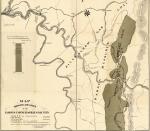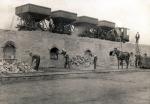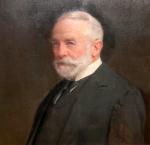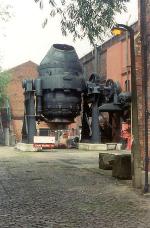Chapter 1: King Coal and Queen Coke
Bituminous coal mining and coke making dominated much of western Pennsylvania's economy during the late nineteenth and early twentieth century. From a scattering of mines in southwestern Pennsylvania in the late eighteenth century, the industry spawned hundreds of mines across western Pennsylvania that produced 177 million tons of bituminous coal in 1918. Mining companies especially exploited the lucrative Pittsburgh coal seam in southwestern Pennsylvania to manufacture coke for the iron and steel industry. "Queen Coke" took its place alongside "King Coal" in economic importance in southwestern Pennsylvania. However, King Coal and Queen Coke were dethroned during the mid- and late twentieth century. After peaking in 1918, the Pennsylvania bituminous industry entered a long-term decline that continues today.
The mammoth bituminous industry had humble beginnings. Europeans found coal in southwestern Pennsylvania as early as the 1740s. The first mining of Pittsburgh coal began about 1760. During the late eighteenth and early nineteenth century, settlers found coal in other parts of western and central Pennsylvania, including the first
first mining of Pittsburgh coal began about 1760. During the late eighteenth and early nineteenth century, settlers found coal in other parts of western and central Pennsylvania, including the first  coal discovery in Tioga County in 1792. Most of the early mines were small and sold coal in local markets for home heating and cooking. Expensive transportation and the widespread availability of cheap wood for use as fuel retarded the expansion of mines and markets.
coal discovery in Tioga County in 1792. Most of the early mines were small and sold coal in local markets for home heating and cooking. Expensive transportation and the widespread availability of cheap wood for use as fuel retarded the expansion of mines and markets.
In the mid-nineteenth century, two critical changes spurred enormous growth in the industry. Railroads spread into bituminous coal fields, providing cheaper, bulk transportation to much wider markets. For example, the Corning and Blossburg Railroad completed construction of a rail line from Tioga County to southern New York in 1840, enabling operators who mined
Corning and Blossburg Railroad completed construction of a rail line from Tioga County to southern New York in 1840, enabling operators who mined  Blossburg coal in Tioga County to boost production and transport coal to markets in southern New York and beyond. Also, new uses for bituminous coal developed. By the late 1800s, railroad companies were also major consumers of bituminous coal, using it to fuel their locomotives, while steamship lines and industrial plants bought bituminous coal to fire steam engines.
Blossburg coal in Tioga County to boost production and transport coal to markets in southern New York and beyond. Also, new uses for bituminous coal developed. By the late 1800s, railroad companies were also major consumers of bituminous coal, using it to fuel their locomotives, while steamship lines and industrial plants bought bituminous coal to fire steam engines.
The most important customers were iron and steel mills, which devoured coke made from bituminous coal in beehive coke ovens. The iron industry switched from charcoal as fuel to anthracite coal during the mid-nineteenth century, and then changed again to coke by the late nineteenth century (see
coke ovens. The iron industry switched from charcoal as fuel to anthracite coal during the mid-nineteenth century, and then changed again to coke by the late nineteenth century (see  Clay Furnace). This demand fueled the rapid expansion of mining in the Pittsburgh seam, which was the best coal in the nation for making coke and was located near the quickly growing iron and steel industry centered in Pittsburgh. Coal production from the Pittsburgh seam soared from 4.3 million tons in 1880 to a peak of forty million tons in 1916.
Clay Furnace). This demand fueled the rapid expansion of mining in the Pittsburgh seam, which was the best coal in the nation for making coke and was located near the quickly growing iron and steel industry centered in Pittsburgh. Coal production from the Pittsburgh seam soared from 4.3 million tons in 1880 to a peak of forty million tons in 1916.
This enormous growth had vast ramifications for southwestern Pennsylvania. Thousands of workers, many of them immigrants from eastern and southern Europe, flowed into the region and provided cheap labor for mines and coke works. Growth also brought ancillary industries and jobs into the region, such as brick makers, railroads, and equipment manufacturers. Towns dependent on mining coal or making coke rose where farms had been before. Between 1890 and 1910 the population of Westmoreland and Fayette counties doubled. Some saw this growth as astounding progress.
In 1899 the compilers of Nelson's Biographical Dictionary wrote about Uniontown, "The coke ovens flame in all directions in the region round about; the very poetry of manufacturing industry is exhibited as their lurid glow sometimes blends with the mellow light of the moon, or the maiden splendor of the evening star. Lines of railway traverse the town, the streets are full of life and energy."
Some residents benefited handsomely from the coal and coke industry. Henry Clay Frick became a millionaire by his thirtieth birthday in 1879, and he and his company dominated the coke industry during the late nineteenth century. But for many workers, mining and coke manufacturing brought hardships.
Henry Clay Frick became a millionaire by his thirtieth birthday in 1879, and he and his company dominated the coke industry during the late nineteenth century. But for many workers, mining and coke manufacturing brought hardships.
In 1915, Harvard economist Frank Taussig reported that "Multitudes of newly arrived immigrants have been drawn to the mines, partly through deliberate arrangement by the employers, partly by the silent adjustment of supply to demand. There they have huddled–inert, stolid, half-enslaved…. In times of activity their condition is passable. In the periods of depression which recur in the iron trade, the price of coke sinks, production is restricted, wages fall, and the barest living is all that the miners and coke workers can secure–sometimes not even this." Employers such as Frick bitterly opposed workers' efforts to organize unions or strike for better pay and working conditions, resulting in sometimes violent labor-management confrontations such as the Morewood Massacre in 1891.
Morewood Massacre in 1891.
The bituminous coal industry grew in other parts of western Pennsylvania during the early twentieth century as operators expanded production to meet rising demand. In 1910 the Ebensburg Coal Company started building Colver in Cambria County on farm land underlain with coal seams. In 1913, employees extracted 600,000 tons of coal from beneath the new town, and in 1926 output increased to 900,000 tons. But as Colver's production expanded, Pennsylvania's bituminous coal industry began a long-term decline.
Cambria County on farm land underlain with coal seams. In 1913, employees extracted 600,000 tons of coal from beneath the new town, and in 1926 output increased to 900,000 tons. But as Colver's production expanded, Pennsylvania's bituminous coal industry began a long-term decline.
After peaking in 1918, output plummeted by two-thirds to fifty-eight million tons in 1993. Pennsylvania bituminous mines encountered rising competition and shrinking markets from several major sources: petroleum and natural gas became cheaper and more abundant fuels, especially for home heating; markets such as coal-fired railroad locomotives withered or disappeared as technology changed (diesel locomotives, for example, replaced steam locomotives); and coal production increased in other states that had lower wage rates or coal that met federal air pollution standards at lower cost.
As production collapsed, operators closed hundreds of mines, throwing thousands of miners out of work and devastating the towns dependent on the industry. Pennsylvania mine owners tried to meet competition by cutting wage rates during the 1920s and early 1930s, leading the United Mine Workers of America to mount multiple strikes. Operators also heavily mechanized their operations, greatly increasing workers' productivity and drastically cutting the labor force. They also moved from underground mines to surface or strip mines, which usually cost less to operate, but created severe environmental damage until state law began requiring land restoration in 1963.
Colver became a case in point as the industry declined. Annual production from the Colver mine peaked at one million tons during the late 1940s; thereafter, output fell as the mining company depleted the coal it owned. Miners, their families, and some of the businesses left town. On October 18, 1978, Lido Sisti, the last mine supervisor, closed up the remaining entrance to the mine; he matter-of-factly scrawled the date, time, and his initials on the wall he helped construct to seal the mine. Sisti, the son of an Italian-immigrant miner, had worked in the mines for thirty-three years. Owners and managers wrote similar epitaphs for many other mines across western Pennsylvania.
The mammoth bituminous industry had humble beginnings. Europeans found coal in southwestern Pennsylvania as early as the 1740s. The
In the mid-nineteenth century, two critical changes spurred enormous growth in the industry. Railroads spread into bituminous coal fields, providing cheaper, bulk transportation to much wider markets. For example, the
The most important customers were iron and steel mills, which devoured coke made from bituminous coal in beehive
This enormous growth had vast ramifications for southwestern Pennsylvania. Thousands of workers, many of them immigrants from eastern and southern Europe, flowed into the region and provided cheap labor for mines and coke works. Growth also brought ancillary industries and jobs into the region, such as brick makers, railroads, and equipment manufacturers. Towns dependent on mining coal or making coke rose where farms had been before. Between 1890 and 1910 the population of Westmoreland and Fayette counties doubled. Some saw this growth as astounding progress.
In 1899 the compilers of Nelson's Biographical Dictionary wrote about Uniontown, "The coke ovens flame in all directions in the region round about; the very poetry of manufacturing industry is exhibited as their lurid glow sometimes blends with the mellow light of the moon, or the maiden splendor of the evening star. Lines of railway traverse the town, the streets are full of life and energy."
Some residents benefited handsomely from the coal and coke industry.
In 1915, Harvard economist Frank Taussig reported that "Multitudes of newly arrived immigrants have been drawn to the mines, partly through deliberate arrangement by the employers, partly by the silent adjustment of supply to demand. There they have huddled–inert, stolid, half-enslaved…. In times of activity their condition is passable. In the periods of depression which recur in the iron trade, the price of coke sinks, production is restricted, wages fall, and the barest living is all that the miners and coke workers can secure–sometimes not even this." Employers such as Frick bitterly opposed workers' efforts to organize unions or strike for better pay and working conditions, resulting in sometimes violent labor-management confrontations such as the
The bituminous coal industry grew in other parts of western Pennsylvania during the early twentieth century as operators expanded production to meet rising demand. In 1910 the Ebensburg Coal Company started building Colver in
After peaking in 1918, output plummeted by two-thirds to fifty-eight million tons in 1993. Pennsylvania bituminous mines encountered rising competition and shrinking markets from several major sources: petroleum and natural gas became cheaper and more abundant fuels, especially for home heating; markets such as coal-fired railroad locomotives withered or disappeared as technology changed (diesel locomotives, for example, replaced steam locomotives); and coal production increased in other states that had lower wage rates or coal that met federal air pollution standards at lower cost.
As production collapsed, operators closed hundreds of mines, throwing thousands of miners out of work and devastating the towns dependent on the industry. Pennsylvania mine owners tried to meet competition by cutting wage rates during the 1920s and early 1930s, leading the United Mine Workers of America to mount multiple strikes. Operators also heavily mechanized their operations, greatly increasing workers' productivity and drastically cutting the labor force. They also moved from underground mines to surface or strip mines, which usually cost less to operate, but created severe environmental damage until state law began requiring land restoration in 1963.
Colver became a case in point as the industry declined. Annual production from the Colver mine peaked at one million tons during the late 1940s; thereafter, output fell as the mining company depleted the coal it owned. Miners, their families, and some of the businesses left town. On October 18, 1978, Lido Sisti, the last mine supervisor, closed up the remaining entrance to the mine; he matter-of-factly scrawled the date, time, and his initials on the wall he helped construct to seal the mine. Sisti, the son of an Italian-immigrant miner, had worked in the mines for thirty-three years. Owners and managers wrote similar epitaphs for many other mines across western Pennsylvania.
















